Summaries
Preface
The preface gives an outline of the known civilizations in Europe and around the Mediterranean in antiquity. It highlights certain unanswered questions and inconsistencies in the accepted theories of man’s journey from the stone and bronze ages to the iron age.
Chapter 1 - The Bad Times
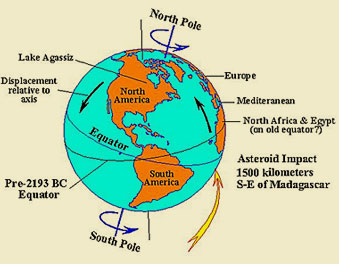 Chapter 1 examines scientific and historical evidence of a cataclysmic disaster that devastated earth in 2193 BC, some 4200 years ago. The event was so severe that it caused the simultaneous collapse of the Old Kingdom in Egypt, the empire of Akkad in Mesopotamia, the Harappan civilization in India, the Hongsan culture in China and the Fryan Federation in Europe. Apart from the European civilization, all these have been dated and verified by modern dating methods. This information was not available in the 19th century when the story was first picked up. An ancient and controversial book that was discovered in 1867 in the Netherlands gives a very graphical description of the event and its impact on Europe. The book, which became known as "The Oera Linda Book", describes an advanced maritime civilization that existed in Western Europe at the time. The findings of modern scholars in archaeology, climatology, oceanography and genetics are compared with the Oera Linda Book’s claims as well as with a number of other scribes in antiquity. The most likely cause of the disaster, based on late 20th and early 21st century research, is presented. The results not only prove the event and its disastrous impact beyond reasonable doubt, but also confirm the authenticity of the Oera Linda Book.
Chapter 1 examines scientific and historical evidence of a cataclysmic disaster that devastated earth in 2193 BC, some 4200 years ago. The event was so severe that it caused the simultaneous collapse of the Old Kingdom in Egypt, the empire of Akkad in Mesopotamia, the Harappan civilization in India, the Hongsan culture in China and the Fryan Federation in Europe. Apart from the European civilization, all these have been dated and verified by modern dating methods. This information was not available in the 19th century when the story was first picked up. An ancient and controversial book that was discovered in 1867 in the Netherlands gives a very graphical description of the event and its impact on Europe. The book, which became known as "The Oera Linda Book", describes an advanced maritime civilization that existed in Western Europe at the time. The findings of modern scholars in archaeology, climatology, oceanography and genetics are compared with the Oera Linda Book’s claims as well as with a number of other scribes in antiquity. The most likely cause of the disaster, based on late 20th and early 21st century research, is presented. The results not only prove the event and its disastrous impact beyond reasonable doubt, but also confirm the authenticity of the Oera Linda Book.
Chapter 2 - The Fryan Federation
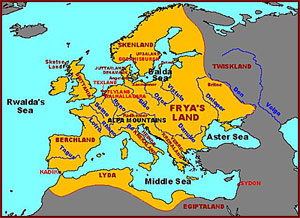 Chapter 2 examines the Oera Linda Book’s description of their hereto unknown civilization in Western Europe. Their geographical location, socio-political dispensation, religion and iron age level of development is described and compared with ancient scribes from Greece. The comparisons and analyses reveal astonishing results. It explains in detail the origins of the "Greek" Alphabet, Indo-Arabian numerals, the 24 hour day, democracy, free enterprise and monotheism. In fact, apart from technology, their society and culture were on a par with modern Western Civilization. Until now historians and archaeologists considered Europe to have been inhabited by Stone-age Neolithics at the time when in fact it was the most advanced civilization on earth.
Chapter 2 examines the Oera Linda Book’s description of their hereto unknown civilization in Western Europe. Their geographical location, socio-political dispensation, religion and iron age level of development is described and compared with ancient scribes from Greece. The comparisons and analyses reveal astonishing results. It explains in detail the origins of the "Greek" Alphabet, Indo-Arabian numerals, the 24 hour day, democracy, free enterprise and monotheism. In fact, apart from technology, their society and culture were on a par with modern Western Civilization. Until now historians and archaeologists considered Europe to have been inhabited by Stone-age Neolithics at the time when in fact it was the most advanced civilization on earth.
Chapter 3 - Legacy of the Outcasts
 After the Global disaster of 2193 BC, survivors from Central Asia and the Far East migrated into Europe and Scandinavia. This inevitably brought them in conflict with the inhabitants of Europe. The Oera Linda Book’s account is compared with modern genetic and linguistic theories as well as with numerous scribes from antiquity. In every instance the book’s claims are proven as fact. Some very fascinating incidents are recounted. The chapter details the events that lead to the founding of Tyre, Marseilles, Athens and Rome.
After the Global disaster of 2193 BC, survivors from Central Asia and the Far East migrated into Europe and Scandinavia. This inevitably brought them in conflict with the inhabitants of Europe. The Oera Linda Book’s account is compared with modern genetic and linguistic theories as well as with numerous scribes from antiquity. In every instance the book’s claims are proven as fact. Some very fascinating incidents are recounted. The chapter details the events that lead to the founding of Tyre, Marseilles, Athens and Rome.
It also explains the origins of the Celts, the Gauls and the Phoenicians. The Phoenicians’ advancement to naval dominance of the Mediterranean, as well as the origins of the Hyksos Dynasty in Lower Egypt is attributed to migrants from Western Europe.
Chapter 4 - The Seeds of a Civilization
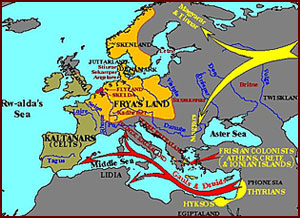 Chapter 4 describes the founding and early years of Athens and the Hellenic civilization by refugees from present day Norway, Denmark and the Netherlands; from 1628 BC to ca 1556 BC. It shows that democracy was not a Greek invention, but originated in Western Europe. It relates the establishment of the Middle Minoan Civilization on the Island of Crete as well as the origins of the mysterious "Sea People" we encounter in Egyptian history and who had such a profound influence on later developments in Turkey and Anatolia (Asia Minor). The Minoan Civilization was only discovered in the 20th century. Special mention is made of the Barbarians, or speakers of the "Bar-bar" language. It is suggested that they were in fact the bearers of civilization. The Greeks and Spartans on the other hand, were the savages. Alexander the Great did not propagate civilization but abrogated the advanced empires of Phrygia and Persia. If anything, he destroyed civilization; unlike the biased accounts of the ancient Greek historians. Again, every statement is substantiated by modern discoveries and numerous scribes from antiquity.
Chapter 4 describes the founding and early years of Athens and the Hellenic civilization by refugees from present day Norway, Denmark and the Netherlands; from 1628 BC to ca 1556 BC. It shows that democracy was not a Greek invention, but originated in Western Europe. It relates the establishment of the Middle Minoan Civilization on the Island of Crete as well as the origins of the mysterious "Sea People" we encounter in Egyptian history and who had such a profound influence on later developments in Turkey and Anatolia (Asia Minor). The Minoan Civilization was only discovered in the 20th century. Special mention is made of the Barbarians, or speakers of the "Bar-bar" language. It is suggested that they were in fact the bearers of civilization. The Greeks and Spartans on the other hand, were the savages. Alexander the Great did not propagate civilization but abrogated the advanced empires of Phrygia and Persia. If anything, he destroyed civilization; unlike the biased accounts of the ancient Greek historians. Again, every statement is substantiated by modern discoveries and numerous scribes from antiquity.
Chapter 5 - Expulsion
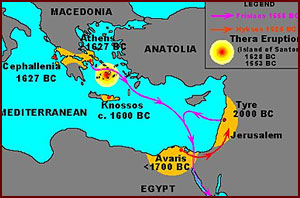 In ca 1556 BC a revolt broke out in Athens. Elements of the original founders were expelled and fled to India. During the same period, in ca 1525 BC, the Hyksos Dynasty in Lower Egypt came to a fall and were forced to flee to Palestine where they settled in and around Jerusalem. The expulsion of the Hyksos from the Nile Delta is ascribed to the economic policies of the Biblical Vice- Pharaoh, Joseph. These developments coincided with a massive eruption of the Thera Volcano on the Santorini Islands. The chapter relates the interaction between the Frisians, the Jews, the Hyksos, the Egyptians and the Philistines and how Jewish and Egyptian religion was first introduced and influenced by the monotheists from Western Europe.
In ca 1556 BC a revolt broke out in Athens. Elements of the original founders were expelled and fled to India. During the same period, in ca 1525 BC, the Hyksos Dynasty in Lower Egypt came to a fall and were forced to flee to Palestine where they settled in and around Jerusalem. The expulsion of the Hyksos from the Nile Delta is ascribed to the economic policies of the Biblical Vice- Pharaoh, Joseph. These developments coincided with a massive eruption of the Thera Volcano on the Santorini Islands. The chapter relates the interaction between the Frisians, the Jews, the Hyksos, the Egyptians and the Philistines and how Jewish and Egyptian religion was first introduced and influenced by the monotheists from Western Europe.
Chapter 6 - The Punjab
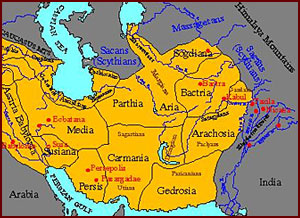 The refugees from Athens, under the leadership of Gert, became known as the "Gertmanne" and settled in the Punjab in present day Pakistan. In time they migrated west and founded the Persian Empire. Undeniable and astonishing evidence is presented to show that they were the Aryans and the gods in the Rig-Veda, the holy scriptures of Hinduism. Their influence on Zoroastrianism, the ancient religion of Iran and Persia, is well documented. This chapter shows that present day linguistic theories are incorrect and that the term Indo-European has no basis in fact. Natural mummified Caucasian bodies found in the Tarim Basin in Western China during the 1980’s and dated to ca 1500 BC confirm the claims of the Oera Linda Book that they settled in the region during the same time. As with all the previous civilizations mentioned, these pioneers from Western Europe led South and South-West Asia and the Middle East out of the Stone and Bronze Ages into the Iron Age. They brought literacy, paper, democracy, cavalry charges and chariot warfare to the region. Their existence and influence are confirmed by accounts of Alexander the Great’s exploits as well as from the writings of numerous ancient scribes and modern scientific research, such as DNA profiling.
The refugees from Athens, under the leadership of Gert, became known as the "Gertmanne" and settled in the Punjab in present day Pakistan. In time they migrated west and founded the Persian Empire. Undeniable and astonishing evidence is presented to show that they were the Aryans and the gods in the Rig-Veda, the holy scriptures of Hinduism. Their influence on Zoroastrianism, the ancient religion of Iran and Persia, is well documented. This chapter shows that present day linguistic theories are incorrect and that the term Indo-European has no basis in fact. Natural mummified Caucasian bodies found in the Tarim Basin in Western China during the 1980’s and dated to ca 1500 BC confirm the claims of the Oera Linda Book that they settled in the region during the same time. As with all the previous civilizations mentioned, these pioneers from Western Europe led South and South-West Asia and the Middle East out of the Stone and Bronze Ages into the Iron Age. They brought literacy, paper, democracy, cavalry charges and chariot warfare to the region. Their existence and influence are confirmed by accounts of Alexander the Great’s exploits as well as from the writings of numerous ancient scribes and modern scientific research, such as DNA profiling.
Chapter 7 - Homeward Bound
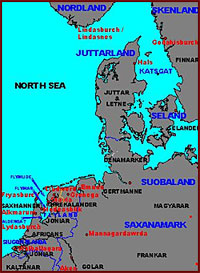 One thousand two hundred years after the Gertmanne settled in the Punjab, a remnant returned with Alexander the Great’s armies to the Mediterranean. They became involved in the power struggle which resulted after Alexander’s death and were instrumental in destroying Egypt’s naval dominance. They also destroyed a number of Greek vessels and defeated the Phoenician fleet in a sea battle. After their exploits in the Eastern Mediterranean they returned to Western Europe in ca 303 BC. The western seaboard of Europe had been destroyed two years earlier by massive tsunamis. Oceanographic research shows that the East coast of North America suffered the same fate at the time. Prominent scientists on cosmic impacts such as Dr Dallas Abbot suggest that a major impact event occurred in the North Atlantic in ca 300 BC. The remainder of the chapter describes the repopulation of Denmark and the Netherlands. It relates the dawning of the age of the Vikings and Germans and the events and policies that resulted in the final demise of this West European empire.
One thousand two hundred years after the Gertmanne settled in the Punjab, a remnant returned with Alexander the Great’s armies to the Mediterranean. They became involved in the power struggle which resulted after Alexander’s death and were instrumental in destroying Egypt’s naval dominance. They also destroyed a number of Greek vessels and defeated the Phoenician fleet in a sea battle. After their exploits in the Eastern Mediterranean they returned to Western Europe in ca 303 BC. The western seaboard of Europe had been destroyed two years earlier by massive tsunamis. Oceanographic research shows that the East coast of North America suffered the same fate at the time. Prominent scientists on cosmic impacts such as Dr Dallas Abbot suggest that a major impact event occurred in the North Atlantic in ca 300 BC. The remainder of the chapter describes the repopulation of Denmark and the Netherlands. It relates the dawning of the age of the Vikings and Germans and the events and policies that resulted in the final demise of this West European empire.
Chapter 8 – Frisland
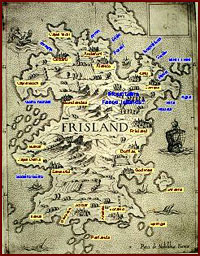 This chapter examines the Oera Linda Book’s claims that their old land (Atland) were located somewhere to the west of Europe and disappeared below the waves in 2193 BC. A map that purportedly dated from 1400 AD, and which had subsequently also been declared a hoax by historians, is examined. The map shows an inhabited land the size of Great Britain to the north-west of Scotland. By superimposing the map on satellite images and contour lines of the ocean floor in the North Atlantic, it was found that the map conforms exactly with the topography which lies at depths in excess of 1000 meters. The author puts forward a likely geological explanation as to what caused the submergence of Frisland. The discovery of this submerged land with its towns and cities may well turn out to be one of the most astonishing archaeological finds in centuries, if not millennia. Prominent geo-scientists in South Africa concurred with the author’s discovery and findings.
This chapter examines the Oera Linda Book’s claims that their old land (Atland) were located somewhere to the west of Europe and disappeared below the waves in 2193 BC. A map that purportedly dated from 1400 AD, and which had subsequently also been declared a hoax by historians, is examined. The map shows an inhabited land the size of Great Britain to the north-west of Scotland. By superimposing the map on satellite images and contour lines of the ocean floor in the North Atlantic, it was found that the map conforms exactly with the topography which lies at depths in excess of 1000 meters. The author puts forward a likely geological explanation as to what caused the submergence of Frisland. The discovery of this submerged land with its towns and cities may well turn out to be one of the most astonishing archaeological finds in centuries, if not millennia. Prominent geo-scientists in South Africa concurred with the author’s discovery and findings.
Chapter 9 – Footprints
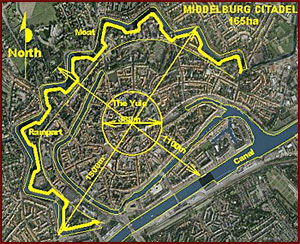 Having proven that the Oera Linda Book is a reliable historical document, the description of their Federation and citadels is compared with satellite images of a number of towns and cities throughout Europe. The results match exactly the Oera Linda Book’s account and prove that some European cities are more than 4000 years old. In fact, they are substantially older than Athens, Rome and Jerusalem.
Having proven that the Oera Linda Book is a reliable historical document, the description of their Federation and citadels is compared with satellite images of a number of towns and cities throughout Europe. The results match exactly the Oera Linda Book’s account and prove that some European cities are more than 4000 years old. In fact, they are substantially older than Athens, Rome and Jerusalem.
Conclusion
The last chapter summarizes the evidence gathered throughout the study and concludes that the Oera Linda Book is a credible historical account. Perhaps the single most important piece of evidence in the old manuscript is locked up in the description of their land before the 2193 BC disaster. Nowhere do they hint at a cosmic impact except for four little inconspicuous words: Before the disaster "the sun rose higher". This is undeniable proof that the Earth’s axis was tilted by the impact. Even the best forger in the 19th century could not have foreseen the overwhelming 21st century AD evidence of a massive asteroid impact with earth in 2193 BC. The author proposes that the existence of an advanced civilization in Europe during the Early Holocene is now a proven fact.
